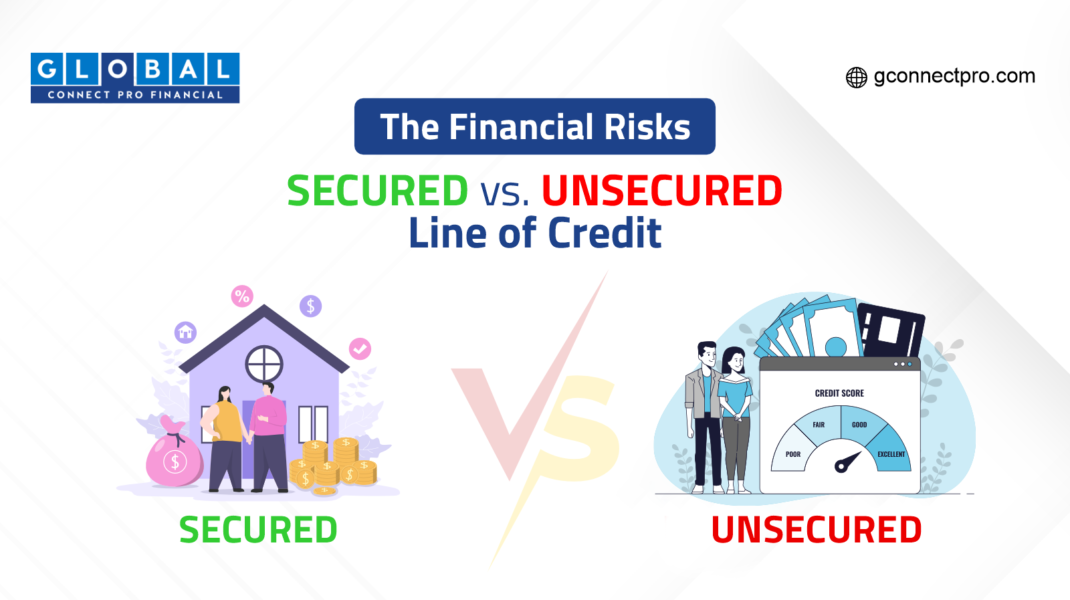Secured vs. Unsecured Line of Credit: Understanding the Key Differences

When it comes to financing options for businesses or personal needs, a line of credit (LOC) is a versatile tool that offers flexibility. However, deciding between a Secured vs. Unsecured Line of Credit can be confusing. Each type has its unique features, benefits, and risks, and understanding these can help you make the best financial decision. In this blog, we’ll explore the key differences between Secured vs. Unsecured Line of Credit and how they might impact your financial strategy.
What is a Line of Credit?
Before diving into the differences, it’s important to understand what a line of credit is. A line of credit is a predetermined amount of money that you can borrow as needed, up to the limit set by the lender. Unlike a traditional loan, where you receive a lump sum, a line of credit allows you to access funds as you require, only paying interest on the amount borrowed. This makes it a popular choice for businesses managing cash flow or individuals handling unexpected expenses.
Now, let’s break down the differences between secured and unsecured lines of credit.
What is a Secured Line of Credit?
A secured line of credit requires you to provide collateral as security against the loan. Collateral can include assets such as property, inventory, or savings accounts, which act as a guarantee for the lender. If you default on the loan, the lender has the right to seize the collateral to recoup the loss.
Advantages of a Secured Line of Credit:
- Lower Interest Rates: Since the loan is backed by collateral, lenders offer lower interest rates as the risk is minimized.
- Higher Credit Limits: A secured LOC often comes with a higher borrowing limit because the collateral increases the lender’s confidence.
- Easier Approval: Even if you have a lower credit score, you may still qualify for a secured LOC due to the collateral provided.
Disadvantages of a Secured Line of Credit:
- Risk of Losing Assets: If you default, the lender can claim your assets, leading to potential financial loss.
- Slower Approval Process: The approval process may take longer as lenders need to evaluate the value of the collateral.
What is an Unsecured Line of Credit?
In contrast, an unsecured line of credit does not require any collateral. Lenders rely on your creditworthiness, income, and financial history to determine your eligibility. Because the lender takes on more risk, unsecured LOCs usually come with stricter approval criteria and higher interest rates.
Advantages of an Unsecured Line of Credit:
- No Collateral Required: Since there’s no need to pledge assets, you won’t risk losing property or savings in the event of a default.
- Faster Approval: The application process is typically quicker because lenders don’t have to assess collateral.
- Flexibility: Unsecured LOCs offer greater flexibility and can be used for a wide range of personal or business expenses.
Disadvantages of an Unsecured Line of Credit:
- Higher Interest Rates: The lack of collateral increases the risk for the lender, leading to higher interest rates.
- Lower Credit Limits: You may have access to a lower borrowing limit since there’s no asset backing the loan.
- Stricter Eligibility: Lenders usually require a strong credit score and financial history to approve an unsecured LOC.
Key Differences Between Secured and Unsecured Line of Credit
Now that we’ve outlined what secured and unsecured lines of credit are, let’s summarize the key differences:
| Feature | Secured Line of Credit | Unsecured Line of Credit |
| Collateral Requirement | Requires collateral, such as property or savings | No collateral required |
| Interest Rates | Typically lower, due to reduced lender risk | Generally higher, reflecting greater risk |
| Credit Limit | Higher borrowing limits available | Lower borrowing limits |
| Approval Process | May take longer due to asset evaluation | Faster approval process |
| Risk | Risk of losing assets if you default | No risk of losing assets, but default affects credit |
| Eligibility | Easier approval for those with lower credit scores | Requires strong credit and financial stability |
Which Line of Credit is Right for You?
Choosing between a Secured vs. Unsecured Line of Credit largely depends on your financial situation, credit score, and the level of risk you’re comfortable with. If you have valuable assets and need a higher credit limit with lower interest rates, a secured LOC may be the better option. However, if you don’t want to risk collateral or prefer faster access to funds, an unsecured LOC might be the way to go.
Final Thoughts
Both secured and unsecured lines of credit have their pros and cons. Understanding the differences between Secured vs. Unsecured Line of Credit can help you choose the option that best fits your financial goals. If you’re unsure which is the best option for you, consult with a financial advisor to explore your options further. Whether you choose a secured or unsecured LOC, it’s essential to borrow responsibly and ensure that you can meet the repayment terms to maintain a strong financial standing.
By weighing your options carefully, you can make informed decisions and use your line of credit to manage cash flow, grow your business, or cover unexpected expenses without unnecessary financial stress.


Write a reply or comment
You must be logged in to post a comment.